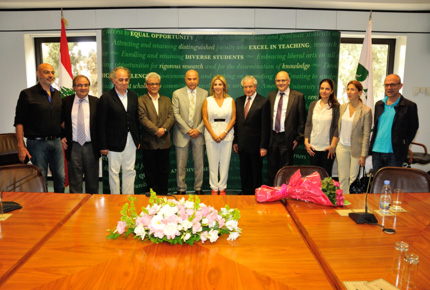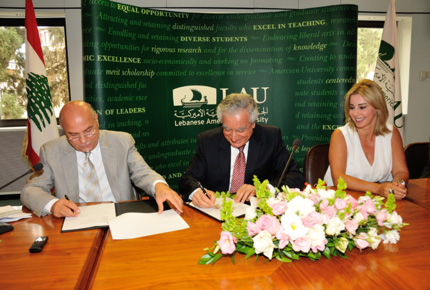Spotlighting Islamic art and architecture
In a first for Lebanon, LAU is to introduce a master’s program in Islamic Art and Architecture.

This endeavor is aimed at promoting the rich scope of contributions made by Islamic civilizations in the arts and sciences throughout history.
The establishment of a new M.A. in Islamic Art and Architecture at LAU by Lebanese-based architect and entrepreneur Mu’taz Sawwaf is aimed at promoting the rich scope of contributions made by Islamic civilizations in the arts and sciences throughout history.
Thanks to a generous endowment from Sawwaf and his wife Rada, the university’s Institute of Islamic Art and Architecture (IIAA) will expand its curriculum from the undergraduate Minor in Islamic Art and Architecture it currently offers to a fully fledged 18-month master’s program starting in the spring of 2015.
“The new postgraduate degree will be one-of-its-kind in the Middle East,” stresses Dr. Abdallah Kahil, director of the IIAA. “While Islamic art and architecture are already well-established academic fields in the West, with major universities in the U.S. and U.K. offering advanced research tracks in these departments, the topic is considerably underdeveloped here in the Middle East,” he adds.
LAU hopes to attract students from around the world to the pioneering program that is located within the Islamic world itself. “The initiative to promote regional research in the Islamic arts is inseparable from LAU’s commitment to expand otherwise marginalized and misrepresented fields of knowledge,” explains Dr. Elie Haddad, dean of the School of Architecture and Design.
As an interdisciplinary domain, the appeal of the M.A. in Islamic Art and Architecture includes graduates with backgrounds in art history, interior design, graphic design, urban studies and anthropology. Functioning as an ideal preparative program for those hoping to go onto higher independent research, the degree will also serve those intending to pursue professional practice. Eager to help launch emerging talent, Sawwaf has extended a welcome to future graduates to join the ranks of his companies and work on various projects in the Islamic world.
As knowledge and skills in Islamic design are increasingly in demand from architects, established practitioners will equally benefit from the program. “The growing global importance of Islamic art will attract and motivate scholars to the program,” says Kahil, pointing at how renowned international museums such as the Louvre and the Metropolitan are being revamped to include major collections of Islamic art.
In his inauguration speech, Sawwaf accentuated the future relevance of exploring Islamic culture and fostering education to counter prevalent misrepresentations. In praising Sawwaf’s generous support for such causes, LAU President Joseph G. Jabbra imparted his faith in the ability of the IIAA’s new master’s program to not only serve as a degree in critical thought on Islamic art theory, but also as a hub to embody solutions in response to contemporary requirements and situations.
From Spain to India, the new master’s degree in Islamic Art and Architecture will encompass a broad area of interest, as well as place Lebanon firmly on the map of international academic research.
“I hope this program gives the Islamic Golden Age of earlier centuries due credit because thanks to it Arab, Persian, Indian, Egyptian and European arts and sciences were preserved, blended and developed to serve as the basis for modern science and culture,” emphasizes Sawwaf.
More
Latest Stories
- LAU Nursing Camp Opens Eyes, Hearts and Futures
- Meet Dr. Zeina Khouri-Stevens, Executive Vice President for Health Services
- LAU Family Medicine Graduates to Benefit from a Partnership With Nova Scotia
- AKSOB Assistant Professor Shares Her Vision for the Future of Learning
- LAU Simulation Models Celebrate 20 Years of Learning, Leadership and Service
- The School of Engineering Hosts the Lebanese Electromagnetics Day
- LAU Stands Out on the Sustainability Scores
- Michael Haddad Walks Again for Climate Change and Food Security


